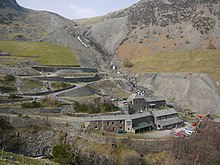Greenside Mine

Site of the former Greenside Mine
|
|
| Location | |
|---|---|
| Location | Glenridding |
| County | Cumbria |
| Country | England |
| Coordinates | 54°32′53″N 2°59′02″W / 54.548°N 2.984°WCoordinates: 54°32′53″N 2°59′02″W / 54.548°N 2.984°W |
| Production | |
| Products | lead, silver |
| Production | 156,000 tons |
| Type | Underground |
| History | |
| Opened | during the 1700s |
| Closed | 1962 |
Greenside Mine (sometimes referred to as Greenside Lead Mine) was a successful lead mine in the Lake District of England. Between 1825 and 1961 the mine produced 156,000 long tons (159,000 tonnes) of lead and 1,600,000 ounces (45 tonnes) of silver, from around 2 million tons of ore. During the 1940s it was the largest producer of lead ore in the UK. Unusually for a 19th-century metalliferous mine in Britain there are very full records of its activities, dating back to 1825.
The mine probably opened during the second half of the 1700s but had closed by 1819. In 1825 the Greenside Mining Company was formed and reopened the mine. They made good profits until 1880, when the price of lead fell. Many other lead mines closed at that time, but the company reduced its costs and continued to work Greenside until 1935. Electricity was introduced to the mine in the 1890s, and it became the first metalliferous mine in Britain to use electric winding engines and an electric locomotive. In 1936 the Basinghall Mining Syndicate Ltd. acquired the mine and turned it into a high volume lead producer. The mine closed in 1962 after lead reserves had been exhausted. Just before it closed the mine was used by the Atomic Weapons Research Establishment (AWRE) to conduct an experiment in detecting seismic signals from underground explosions. Fifteen years after the mine closed mine explorers began to visit the upper levels. They cleared the entrances and several roof falls, and today they are able to pass through the mine using an old escape route.
All the ore produced by the mine came from the Greenside Vein, a mineral vein which filled a geological fault running in a north-south direction through the east ridge of Green Side, a mountain in the Helvellyn range. Mining activities traced this fault for a length of 3,900 feet (1,200 m) and to a depth of 2,900 feet (880 m). Four areas of the vein, known as ore shoots, contained galena, an ore of lead which also contained small amounts of silver. At first the ore was mined simply by driving adits into the mountain-side. To access ore at greater depths, two longer levels were driven from lower down but further away, and then a series of shafts were sunk within the mine. The lowest point in the mine was roughly 100 m below sea level, where the surrounding andesite rock rested upon underlying shales in which the fault had not been mineralised.
...
Wikipedia

